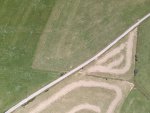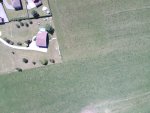- Joined
- May 25, 2019
- Messages
- 4
- Reaction score
- 0
Testing a Parrot Sequoia and the RGB photos are terrible. It's not a drone speed issue as I tried even on the lowest speed setting in Pix4D Capture. When you have motion blur issues it's consistent throughout the image. This is the strangest thing I've ever seen in that it has what looks like bands of blurriness as some bands of areas like more detailed than others. Trying to determine if I have a bad RGB camera sensor. The other camera the images are consistent detail throughout the frame.
This is 4 inch/pixel GSD (135 feet AGL)
I know 4 in/pixel is not very high resolution but the images look very abnormal. Again, this is flying at slowest speed setting. There was absolutely no difference in the image between the fastest and slowest setting.
This is 4 inch/pixel GSD (135 feet AGL)
I know 4 in/pixel is not very high resolution but the images look very abnormal. Again, this is flying at slowest speed setting. There was absolutely no difference in the image between the fastest and slowest setting.






